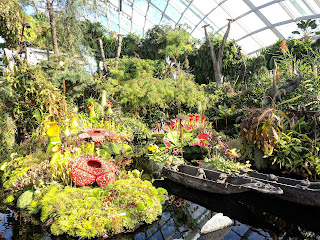Regardless of whether you’ve been gardening for ages or are a novice when it comes to this hobby, you’re surely always on the lookout for hacks that can make you a better gardener. Additionally, you certainly know how important water can be for the health of your plants. However, seeing as how four billion people across the globe experience severe water scarcity, conserving water should also be high among your priorities when taking care of your garden. If you’re not sure how to save water, keep these six tips in mind.
Save water from
your household and collect rainwater
For starters, it’s best if you can collect water around the
house instead of using tap water or buying bottled water to water your garden.
Start by recycling water that you use inside your home. For example, you can
collect the water you used to boil pasta, vegetables, and other foods. Anything
that is left behind in glasses, pitchers, and bottles should also be put into a
larger container that you will use for watering your crops. Furthermore, water
from the bathroom that isn’t used, such as the cold water that you let go down
the drain, can also be preserved for when your plants are thirsty. Finally, besides
collecting water around the house, you can also collect rainwater. There are
various systems that you can use to harvest water so look into the solution
that will work best for you.
Grow plants
that don’t need a lot of water
In addition to collecting water from various sources, you
should also conserve water by learning more about the plants you intend on
growing. While it’s always a good idea to do research before you plant
anything, you especially want to pay attention to how much water a plant
requires. Although you might want a big variety of veggies, fruits, and herbs,
opting for those that won’t need huge amounts of water can be both good for
your wallet and the environment. For instance, lime and pole beans, field peas,
cowpeas, and black-eyed peas as well as corn, summer squashes, and most herbs
are all drought-tolerant and thrive in hot climates. Moreover, planting crops
closer together means that they will require less water.
Know when to
water the plants
Something else that is vital when trying to save water is
knowing when to water your plants. Research shows that crops that are planted
in the ground do best when they are watered in the morning while those in pots
should be watered in the afternoon. This depends on the soil the plants are in
as traditional soil and potting mixes have different properties in terms of
moisture retention. What is more, the soil type also plays a role. For example,
clay-based soils require more water but less frequent watering. Lastly,
watering at the wrong time can also result in more evaporation.
Get the right
equipment
To save water, it’s also essential to have the right
equipment. For starters, a moisture meter is a great tool that will tell you
exactly when you need to water. Then, a quality hose and retractable hose reel that will let you control exactly
how much water you’re using will also be helpful. Other tools that will come in
handy are timers that allow you to schedule watering your plants even when
you’re not home as well as watering cans that will let you measure how much
water you are using.
Use mulch to
lock in moisture
You always want to prevent evaporation, which is why applying
mulch in the spring is imperative. Doing this will ensure the moisture is
locked in. That way, you will not have to water as frequently and you’ll be
able to save water. As mulch comes in different forms, you can even get some
organic alternatives that will get absorbed by the soil over time and feed your
plants as well.
Don’t overwater
your plants
Last but not least, you must ensure you are not overwatering
your plants. This bad habit will not only increase your bills but it can also
lead to root rot and result in your crops dying. So, even if you find yourself
watering once the sun sets, use solar garden lights in order to see how much water
you’re using and how wet the soil is getting.
Water is a precious resource and we should do our best to not
waste it. Keep these six tips in mind to conserve water in your garden.






0 Comments